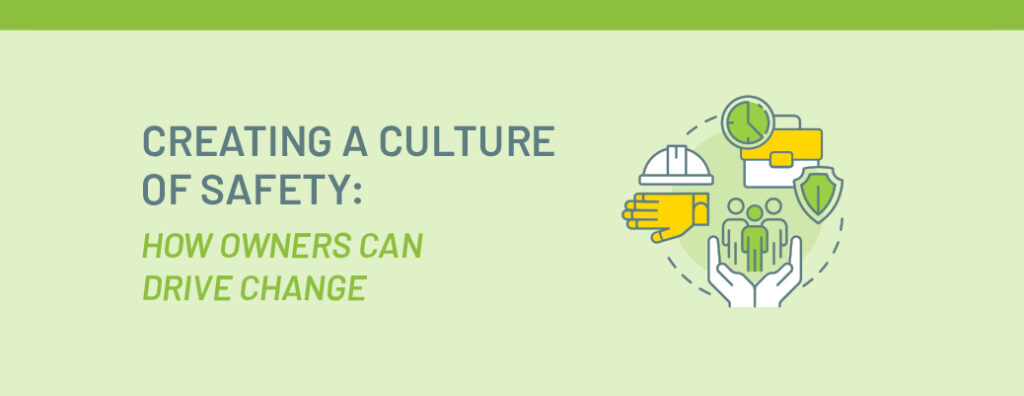
This week, May 6 through 10, the construction industry is celebrating Safety Week, an annual event that emphasizes the importance of safety. This year’s theme, “Value Every Voice,” urges the industry to promote personal responsibility, inclusivity, and a strong safety culture. As with any project, owners play a crucial role in shaping the safety culture of construction projects.
As the Director of Safety for MBP, I have had the privilege of observing a wide range of construction projects. I have concluded that owners who prioritize safety and partner with contractors with similar commitments tend to achieve better results.
The Strategic Position of Owners in Safety Leadership
Owners play a pivotal role in determining the direction of a project. They control major elements such as contract awards, designs, schedules, and budgets, which can significantly impact project outcomes. They have similar and even more important abilities to influence the project’s safety culture. It’s a common misconception that safety leadership and culture develop naturally, but that’s not the case. It must be planned and crafted thoughtfully. As the writer Antoine de Saint-Exupéry expertly said, “A goal without a plan is just a wish.” Owners can embed safety as a core value from the start, creating a culture that pervades every aspect of the project.
Here are eight strategic actions that owners can take to establish a strong safety culture:
1. Safety as Value, Not Just a Priority
We often hear that safety is a priority in our industry. However, priorities can change, whereas values are constant. When safety becomes a core value, it influences every decision and action on the project. For owners, embedding safety as a value means it becomes non-negotiable. This approach ensures that safety is maintained, prevailing over priorities like time or cost when faced with tough decisions. Implementing safety as a core value requires leadership, commitment, and continuous reinforcement. Doing so creates an environment where everyone from the top down understands its importance.
2. Leading by Example
Owners must demonstrate their own commitment to safety through their actions. This visible leadership inspires a similar commitment across all project levels. This can take various forms, from attending safety meetings and audits to supporting safety training initiatives and ensuring adequate safety resources are allocated. By setting clear safety expectations and being involved in safety planning and implementation, owners help foster an environment where safety is everyone’s responsibility. Their participation elevates safety standards and demonstrates the utmost importance of the well-being of every individual.
3. Communication in Safety Practices
Clear communication of safety expectations forms the backbone of a strong safety culture. From day one, everyone involved in the project must understand what is expected of them. This begins with leadership setting explicit safety goals. Effective methods to communicate these expectations include safety orientations, regular safety meetings, and clear signage on site. It is also important to embed these expectations in all project documentation and contracts, ensuring they are formalized and unambiguous. By implementing these communication strategies, owners ensure that safety information is effectively disseminated, supporting a proactive and responsive safety approach.
4. Safety as a Contractor Selection Criteria
Selecting the right contractor is a decision that goes beyond schedules and budgets. It is about choosing a partner who shares an owner’s dedication to safety. This choice may be one of the most important things an owner makes when setting the project up for success. A contractor’s commitment to safety can significantly influence the project’s overall safety success. Safely run projects are an investment, avoiding workplace incidents that often result in project delays and cost overruns. An owner’s procurement process should prioritize the selection of those contractors who have demonstrated a strong safety ethic and safety record.
5. Comprehensive Hazard Prevention Plans
A well-structured hazard prevention plan identifies potential safety risks at the outset of the project and includes strategies to mitigate these risks. Developing this plan begins with a thorough risk assessment, engaging all project stakeholders, including workers, with their valuable insights into practical safety challenges. Once risks are identified, the plan details specific mitigation strategies, assigns responsibilities for putting those mitigation measures in place, and sets timelines for implementation. The hazard prevention plan is a living document updated as project conditions and risks evolve. By mandating these hazard prevention plans, owners promote a proactive approach to safety, reducing the likelihood of incidents and ensuring a safer project environment for everyone.
6. Regular Safety Audits and Inspections
Proactive safety management should include regular audits and inspections to identify and mitigate potential hazards. These activities should be planned and systematic, covering all aspects of the construction site and operations. The findings from these audits and inspections provide valuable insights into the project’s safety practices and how they can be improved. Moreover, they demonstrate to the workforce that safety is taken seriously, and findings are an opportunity for continuous improvement rather than grounds for punishment.
7. Consistent Engagement and Training
Owners should promote safety education with interactive training sessions and open dialogue that encourage everyone to contribute to safety discussions. These engagement programs reinforce safety practices and encourage active participation by the workforce.
8. Inclusivity in Safety Practices
An important component of Safety Week 2024 is the emphasis on inclusivity. Owners can play a vital part in ensuring everyone feels valued and heard, regardless of their roles or backgrounds. Inclusivity in safety can be fostered through regular forums and feedback mechanisms that encourage the workforce to share their insights and concerns. These platforms provide a valuable opportunity to tap into all project participants’ diverse perspectives and experiences, enhancing collective safety practices. Inclusivity also means recognizing the unique needs and challenges of diverse groups within the workforce and ensuring that safety programs and initiatives address these needs effectively.
An owner’s role in shaping the safety leadership and culture of construction projects is paramount to successful delivery. Owners can ensure their projects meet and exceed safety expectations by taking personal ownership and actively engaging in the safety planning and implementation process. Safety Week 2024 reminds owners of their ability to influence project safety through their dedicated, inclusive, and proactive approach to safety. This commitment leads to safer construction sites and better project outcomes.




